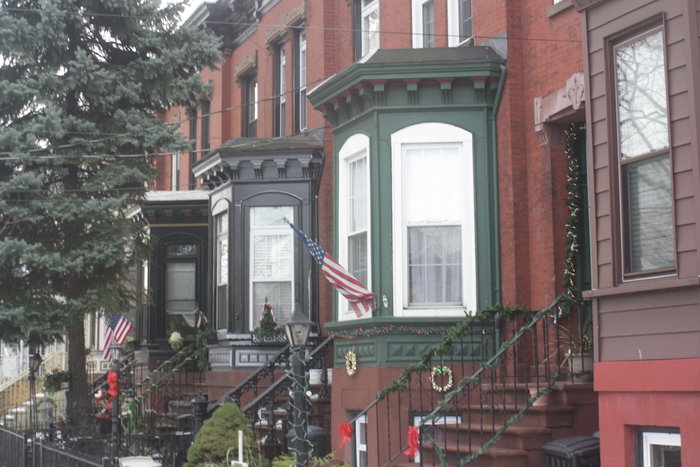Standing in front of the Schuyler Row House at 16 East 33 rd St. this time of year, you can’t help but get into the Christmas spirit.
Constructed in 1878, the building straight out of a Charles Dickens novel, is part of a time in Bayonne history when row houses had become something of a fad.
Dr. Joseph Ryan, who serves on the Bayonne Historic Preservation Commission, said the city is seeking to preserve the building, part of a series of row houses on that street, as a landmark.
“We believe it is a place of historic significance and is an example of townhouse design of that time,” Ryan said.
“The Schuyler Row House,” according to the application for landmark status, “is an excellent example of a late Victorian Italianate-style brick row house with modified features from other styles, designed to appeal to the commuter residents of the first decade of home construction in the City of Bayonne.”
As a real-estate developer, Schuyler was a prolific builder in Bayonne.
“After the Cadmus farmlands were purchased in 1859 by a group of real-estate speculators, Schuyler began watching for opportunities to acquire desirable lots from the land near the Central NJ Train Station at Bayonne Avenue,” according to the Historical Commission. “The 1873 Hopkins Map shows Schuyler by then owning all the lots from Bayonne Avenue (now 33rd Street) to Oakland Avenue (now 32nd Street), including Willow Street from Avenue D to Avenue E as well as the northerly side of Maple Avenue (now 31st Street) also from Avenue D to Avenue E.”
There is no evidence that Schuyler attempted to build on any of these lots until after he retired from Schuyler, Hartley & Graham in 1876 and until the home construction industry started to recover in 1878 from the economic downturn of 1873.
According to a local newspaper published on August 3, 1878, “Mr. Schuyler is building five fine houses on Bayonne Avenue.”
This refers to the five row houses from 12 to 20 East 33rd Street. No. 16 is being nominated for landmark status.
It appears that the five row houses were created as rental properties. In some cases they would temporarily house wealthy real estate customers while permanent “dream homes” were being designed and built for them in Bayonne. At other times, they provided temporary housing for highly-skilled workers who circulated among the various plants that Bayonne industries such as Tidewater Oil and Babcock & Wilcox often maintained at multiple sites throughout the country. Thus, these row houses were still the property of J.R. Schuyler when he died in 1887. A number of tenants had lived in them during his ownership.
After his death in 1887, his children maintained the East 33rd Street row houses as rental properties for many years, selling them in 1896. The sale may have been triggered by a story in the Bayonne Herald on January 11, 1896, that their neighbor William L. Morris had sold his Newark Bay estate to Jersey City lawyer E.K. Seguine, who was expected to resell the property to a business that would build a factory on the site.
The Schuyler children sold 16 East 33rd Street to local grocer Rienzi Cadugan (1841-1918) and his wife Emilie in September 1896. The Cadugans were well-known as the owners of a handsome black stallion named Bayonne Prince who began winning horse races as a four-year-old colt in 1883. Bayonne Prince took first prize at the state fair at Waverly, NJ, in September 1883. The horse was later immortalized in artwork by J. McAuliffe.
A significant developer in Bayonne
Schuyler, the builder, was a native of Belleville, NJ, where his father owned a copper mine. A direct descendent of a Dutch immigrant, he was distantly related to the wife of Alexander Hamilton.
He also married into a historic family. His wife was a great-granddaughter of Christian preacher and theologian Jonathan Edwards who is widely acknowledged to be among the nation’s most important and original philosophical theologians and intellectuals.
Schuyler was a junior member of the firm Smith, Young, and Company, which sold “Military & Fancy goods” in Manhattan. He became the senior member of the firm Schuyler, Hartley & Graham, founded in 1854, which sold similar merchandise from two shops in Manhattan near Wall Street. The company provided arms and military goods for the North at the outbreak of the Civil War. Much like Abercrombie & Fitch during the Spanish-American War, Schuyler’s firm emerged from the Civil War as a great financial success. He retired from this business in 1876.
When the City of Bayonne was incorporated in 1869, Schuyler was elected to the city council, and served as city council president for two terms until 1872.
In early 1871, J.R. Schuyler built a large, brick three-story multi-use public building called the Schuyler Building at the northwest corner of Avenue C and West 8th Street. It featured a large room called Schuyler Hall that became a popular meeting place for educational, fraternal, social, and religious organizations in Bayonne.
The Rev. Henry Ward Beecher (1813-1887), a prominent Congregationalist clergyman, social reformer, abolitionist, and speaker in the late 19th century, as well as brother of author Harriett Beecher Stowe, gave a lecture there in 1881.
In 1872, J.R. Schuyler was one of the incorporators of the Mechanics Trust Company, along with other Bayonne merchants and businessmen. Schuyler and his colleagues are credited as the founders of the Bergen Point Gas-Light Company.
After Schuyler died, the Schuyler Building served first as a Masonic Hall and then temporarily as a Bayonne high school, but it eventually fell to the wrecker’s ball. The land on which it once stood now serves as Edward F. Clark Park named in honor of a former Mayor of the City of Bayonne.
Al Sullivan may be reached at asullivan@hudsonreporter.com.
